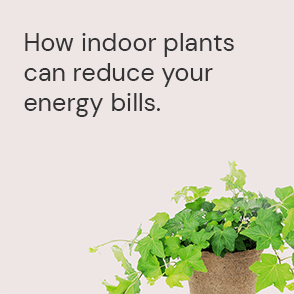ENERGY SAVINGS
How indoor plants
can reduce your
energy bills.
Aside from making your home seriously calming, indoor plants have surprising, and welcome energy saving benefits. As well as being both mood and space enhancing, indoor plants can warm and cool your home across the seasons and improve air quality.
Here we share how indoor plants can lower your energy bill as well as some helpful inspiration on what plants could work best for your home.
Indoor plants regulate humidity.
Indoor plants are natural dehumidifiers. Their leaves absorb water from your home’s surroundings then release moisture into the air through a process called transpiration.
In the hotter months, the increased atmospheric moisture through transpiration can have a cooling effect, reducing the need for air conditioning. One study by Nguyen et al (2021) on the cooling effect of house plants revealed an average reduction of 1°C of the room temperature.
Meanwhile when temperatures drop, the humidity can make air feel warmer and more comfortable. Furthermore, since warm air rises, indoor plants can help circulate it back down towards the floor and distribute heat evenly throughout the room.
Take care of your houseplants by watering them little and often. Try not to overwater, and only when the top inch of soil feels dry.
Indoor plants provide shade, insulation and improve air quality.
If you’re strategic about where you place your indoor plants, you can benefit from their energy saving effect.
Position sun-loving plants with large leaves or dense foliage close to windows or other openings to reduce heat entering during summer and escaping during winter.
Scattering house plants will elevate your well being as well your living space. NASA discovered their ability to purify the air through a process called phytoremediation which neutralises pollutants, airborne particles and harmful moulds or bacteria. If you run an electrical air purifier, indoor plants can help you save further by letting Mother Nature do the job instead. To maximise air purification, NASA recommends one plant every 100 square feet.
What are the best indoor plants to keep the home warm or cool?
As a rule, all soft leaved plants help take moisture out of the air – and the larger or more leaves it has, the more magnified the heating or cooling effect.
When you don’t want to turn up the air conditioner, consider plants that act as natural coolants. Rubber plants, ferns and all types of palms can cool your home. Plants like aloe vera and sansevieria store water in their leaves which evaporates in warm temperatures creating humid, cooler - feeling air.
To add warmth to your spaces in winter, peace lilies will remove toxins from the air while adding humidity to it and can tolerate low light and cool temperatures. Other low-maintenance house plants that thrive well in cooler months you could consider, include golden pothos and indoor evergreens.
Summary
- Through the process of transpiration, indoor plants act as natural dehumidifiers. The resulting increased atmospheric moisture can keep your home warmer in winter and cooler in summer.
- Positioning plants with large leaves or dense foliage close to windows or other openings can reduce heat entering during summer and escaping during winter.
- Through the process of phytoremediation, indoor plants neutralise pollutants, airborne particles and harmful moulds or bacteria.
- Rubber plants, ferns, all types of palms, aloe vera and sansevieria can help cool your home.
- Peace lilies, golden pothos and indoor evergreens thrive well in lower temperatures and can help warm your home.
ActewAGL's energy saving tips are designed to help you take control of your energy use, while reducing your bills and environmental impact. Save with great value energy plans backed by our sustainability promise, supported by 100% local, award-winning service.
Sources
https://ntrs.nasa.gov/citations/19930073077
https://pubs.aip.org/aip/acp/article-abstract/2420/1/020010/1028624/An-experimental-study-on-effects-of-indoor-plants?redirectedFrom=fulltext
Disclaimer: These Energy Savings tips and articles are for information purposes only. Please ensure you are aware of any safety precautions before operating appliances or products.




